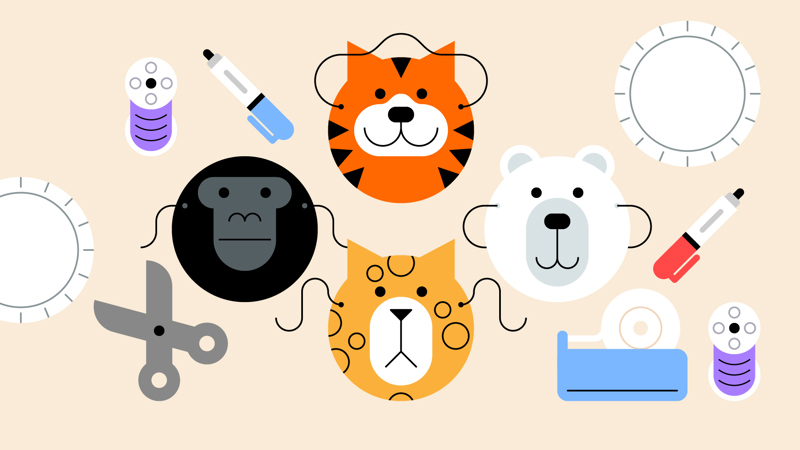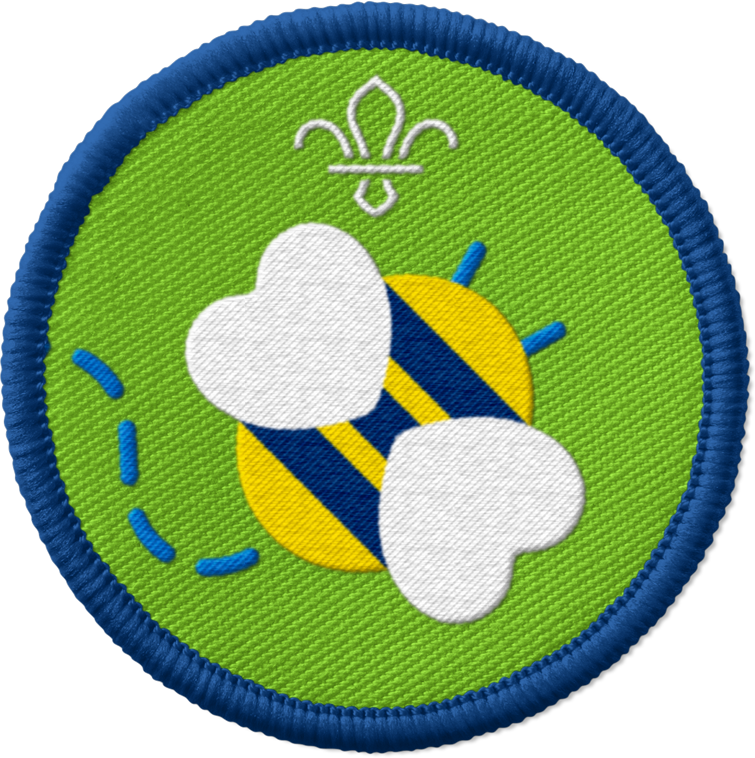
Make animal masks
You’ll need
- Paper plates
- String
- Scissors
- Hole punch
- Craft materials (for example, tissue paper, pipe cleaners, stickers)
Before you begin
- Set up four different tables with everything a group will need to make one of the four animal masks. You may want to assign an adult to each table.
Learn about endangered animals
- The person leading the game should ask everyone what they know about endangered animals. Everyone should try to explain what it means to be endangered, and share some examples of animals that are endangered.
- The person leading the game should explain what endangered animals are, and introduce the tiger, amur leopard, mountain gorilla, and polar bear.
- The person leading the game should give everyone an animal —tiger, amur leopard, mountain gorilla, or polar bear.
- Each animal group should get together. Everyone acting like the animal they’ve been given is one way people could find the other members of their animal group.
- Each animal group should go to the table with the things they need to make their mask.
Make masks
- Everyone should cut eyes and mouth holes in a paper plate. They should try and make sure they match up to their face!
You may want to do this before the activity begins to save time.
- Everyone should use the hole punch to punch one hole on each side of the mask. If there isn’t a hole punch, an adult should carefully pierce the card with scissors — it may be best to do this before the activity.
- Everyone should decorate their mask to look like their animal. They could draw and colour, or use craft materials.
We’ve also included some ‘Animal mask templates’. You could stick these to the paper plates or print them on card instead.
- Everyone should tie string to one of the hole punched holes. They should measure how long the string needs to be to hold the mask to their face, then cut it and tie it on to the other hole punched hole.
Play the endangered animals game
- If their mask is dry (and if they can see through it clearly), everyone could wear their mask while playing this game.
- The animal groups should jumble up, and everyone should sit in a circle.
- The person leading the game should call out the name of one of the endangered animals or a fact about one of the endangered animals from the ‘Wild world facts’ below. They could also call ‘all endangered animals’.
- Everyone in that animal group should get up and move around the outside of the circle like their animal. They could prowl, plod, or run, until they return to their place. If the person leading the game calls ‘wild world’, everyone should get up and move around the outside of the circle like their animal.
- Repeat steps three and four until everyone’s had enough turns.
|
This animal... |
Answer |
Explanation |
|
has orange and black fur. |
Tigers |
Some types of tiger have orange fur with black stripes. Others have white fur with black stripes, or even golden fur with brown stripes. |
|
lives in high forests on mountains. |
Mountain gorillas |
Mountain gorillas live in forests at high altitude (high up). |
|
sleeps during the day. |
Amur leopards |
They’re nocturnal - they sleep in the day and stay awake at night. |
|
is actually black, not white. |
Polar bears |
Polar bears have clear fur that only looks white because it reflects light. Their fur helps keep them camouflaged in the white snow. Underneath all that fur their skin is jet black. |
|
lives in big forests. |
Amur leopards |
Habitat loss is one of the main reasons that amur leopards are endangered. When people cut down forests, the leopards lose their home. |
|
lives in Africa. |
Mountain gorillas |
Mountain gorillas live in Rwanda, Uganda, and the Democratic Republic of the Congo. |
|
lives in Asia. |
Tigers |
Tigers can be found in Bangladesh, Vietnam, Cambodia, India, Bhutan, China, Thailand, Malaysia, Indonesia, Laos, Russia, and Nepal. |
|
lives in the Arctic. |
Polar bears |
Polar bears are found in the frozen wilds of the Arctic, in Canada, Alaska, Greenland, Russia, and Norway. |
|
mostly lives in Russia. |
Amur leopards |
Most amur leopards live in Russia but some live in China. |
|
has fewer than four thousand left in the world. |
Tigers |
One hundred years ago, there were over one hundred thousand tigers. Now there are less than four thousand. |
|
has around one thousand in the world. |
Mountain gorillas |
This is double the number 20 years ago! There are more because of better education, campaigning and conservation efforts. |
|
spends over half of their time hunting for food. |
Polar bears |
Less than two percent of their hunts are successful. They spend so much time hunting to increase their chance of catching food. |
|
only has around 80 adults left in the wild. |
Amur leopards |
They’re critically endangered, which means they’re at very high risk of becoming extinct. |
|
is the largest cat species in the world. |
Tigers
|
Tigers are part of the cat family, like lions and leopards. An average cat weighs around four kilograms. Siberian tigers can weigh over three hundred kilograms. |
|
can run up to 37 miles per hour. |
Amur leopards |
They’re built for speed, which helps them when they’re hunting for prey. |
|
is an excellent swimmer. |
Polar bears |
Polar bears have slightly webbed paws that they use like paddles in the water. |
|
lives in groups called troops. |
Mountain gorillas |
They live in groups of up to 30 gorillas. The group can also be called a band. |
|
is vegetarian. |
Mountain gorillas |
Mountain gorillas are herbivores, they mainly eat leaves. |
|
only eats meat. |
Tigers, polar bears, and amur leopards |
They’re carnivores, which means they only eat meat. Tigers mainly eat deer, buffalo, and wild pigs. Polar bears mainly eat seals. Amur leopard mainly eat deer. |
|
has thick blubber to keep it warm. |
Polar bears |
Polar bears have adapted to survive in one of the coldest places on our planet. They have thick fur and a layer of fat called blubber. This insulates their bodies to help them stay warm. |
|
is hunted for its meat. |
Mountain gorillas |
Mountain gorillas are hunted for bushmeat. |
|
has had their habitat destroyed by mining. |
Mountain gorillas |
People destroy forests to dig materials (including metals) out of the ground. The materials are used to make things such as mobile phones. Buying a new mobile every year increases the demand for mining. |
|
is in danger because of climate change. |
Polar bears |
Global warming makes ice and snow melt so polar bears lose their habitat. |
|
is endangered because of hunting. |
Mountain gorillas, tigers and amur leopards |
People hunt them because they want to sell their meat, fur, or parts – or because they want to keep them in captivity. Hunting is illegal but some poachers still do it because they make a lot of money. Not buying fur (and other animal products) helps reduce the demand for hunting. |
|
is an endangered animal. |
All of them! |
All of these animals are currently classed at vulnerable, endangered, or critically endangered; they’re at an extremely high risk of going extinct. We can help by campaigning against hunting and habitat destruction, and by not buying products that are made using resources that destroy habitats. |
Reflection
This activity reminded you that you’re a local, national, and international citizen of the world. Our world belongs to wildlife too. We need to look after wildlife and not damage their habitats. Animals that need our help don’t just live in countries far away—they can be locally too. Can you remember any animals at risk that live in the UK? How could you work with other people to look after endangered animals?
This activity also reminded you to care. Imagine having an endangered animal with you now. Can you hold it, or is it too big? What does it feel like—is it furry or spiky? Where does it live and what does it eat? Our actions affect animals around the world. What could you do to help this animal (for example, could you pick up litter and avid walking on their habitat, or could you use less energy and recycle more)?
Safety
All activities must be safely managed. You must complete a thorough risk assessment and take appropriate steps to reduce risk. Use the safety checklist to help you plan and risk assess your activity. Always get approval for the activity, and have suitable supervision and an InTouch process.
- Scissors
Supervise young people appropriately when they’re using scissors. Store all sharp objects securely, out of the reach of young people.
- Glue and solvents
Always supervise young people appropriately when they’re using glue and solvent products. Make sure there’s plenty of ventilation. Be aware of any medical conditions that could be affected by glue or solvent use and make adjustments as needed.
- Active games
The game area should be free of hazards. Explain the rules of the game clearly and have a clear way to communicate that the game must stop when needed. Take a look at our guidance on running active games safely.
- It’s up to you how detailed you make your masks. You could add extra features like ears and whiskers.
- You can change the animals if you want to, for example, you may want to choose animals that live in the UK.
- No one has to wear the mask over their face. They can just hold it (away from their face) if they want to.
- Include a range of tactile and textured materials like fake fur and cotton wool so everyone, especially those with visual impairments, can make masks they can feel. No one has to use the textured materials if they don’t want to.
All Scout activities should be inclusive and accessible.
Young people could choose their own animals for the masks.



